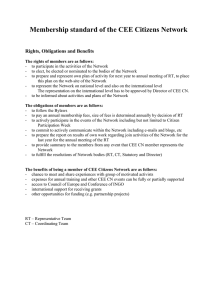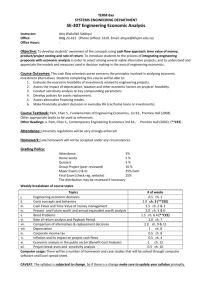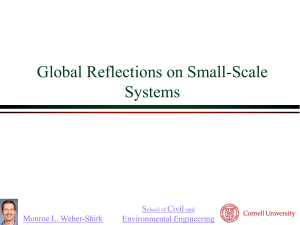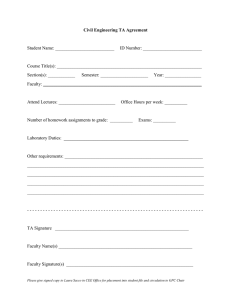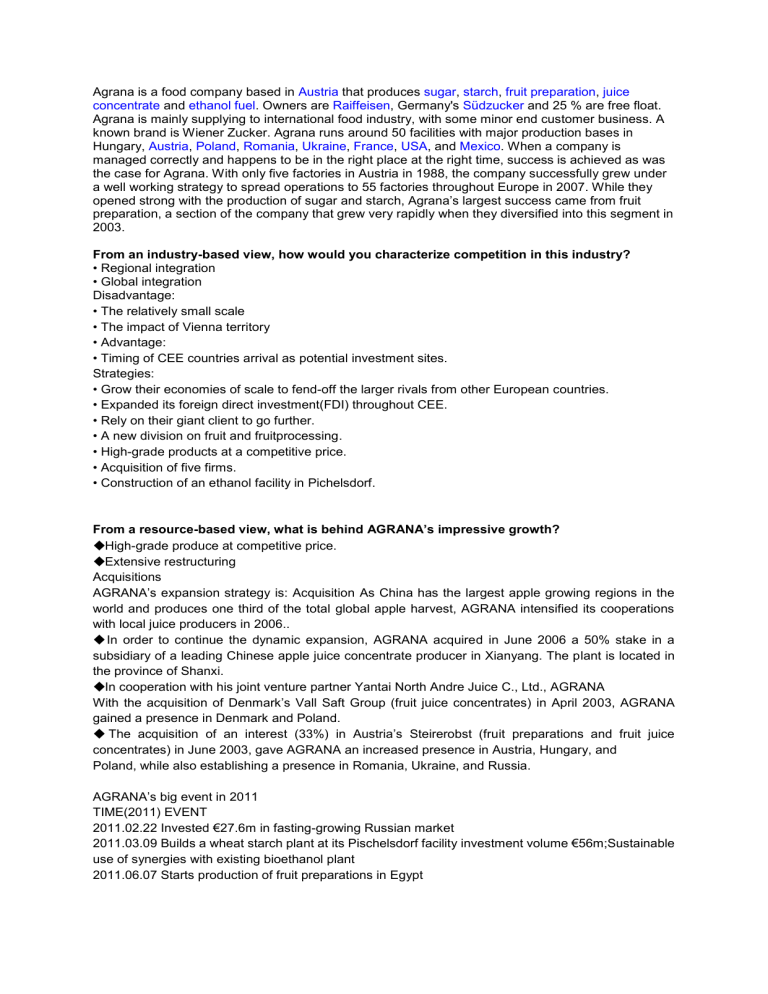
Agrana is a food company based in Austria that produces sugar, starch, fruit preparation, juice concentrate and ethanol fuel. Owners are Raiffeisen, Germany's Südzucker and 25 % are free float. Agrana is mainly supplying to international food industry, with some minor end customer business. A known brand is Wiener Zucker. Agrana runs around 50 facilities with major production bases in Hungary, Austria, Poland, Romania, Ukraine, France, USA, and Mexico. When a company is managed correctly and happens to be in the right place at the right time, success is achieved as was the case for Agrana. With only five factories in Austria in 1988, the company successfully grew under a well working strategy to spread operations to 55 factories throughout Europe in 2007. While they opened strong with the production of sugar and starch, Agrana’s largest success came from fruit preparation, a section of the company that grew very rapidly when they diversified into this segment in 2003. From an industry-based view, how would you characterize competition in this industry? • Regional integration • Global integration Disadvantage: • The relatively small scale • The impact of Vienna territory • Advantage: • Timing of CEE countries arrival as potential investment sites. Strategies: • Grow their economies of scale to fend-off the larger rivals from other European countries. • Expanded its foreign direct investment(FDI) throughout CEE. • Rely on their giant client to go further. • A new division on fruit and fruitprocessing. • High-grade products at a competitive price. • Acquisition of five firms. • Construction of an ethanol facility in Pichelsdorf. From a resource-based view, what is behind AGRANA’s impressive growth? ◆High-grade produce at competitive price. ◆Extensive restructuring Acquisitions AGRANA’s expansion strategy is: Acquisition As China has the largest apple growing regions in the world and produces one third of the total global apple harvest, AGRANA intensified its cooperations with local juice producers in 2006.. ◆ In order to continue the dynamic expansion, AGRANA acquired in June 2006 a 50% stake in a subsidiary of a leading Chinese apple juice concentrate producer in Xianyang. The plant is located in the province of Shanxi. ◆In cooperation with his joint venture partner Yantai North Andre Juice C., Ltd., AGRANA With the acquisition of Denmark’s Vall Saft Group (fruit juice concentrates) in April 2003, AGRANA gained a presence in Denmark and Poland. ◆ The acquisition of an interest (33%) in Austria’s Steirerobst (fruit preparations and fruit juice concentrates) in June 2003, gave AGRANA an increased presence in Austria, Hungary, and Poland, while also establishing a presence in Romania, Ukraine, and Russia. AGRANA’s big event in 2011 TIME(2011) EVENT 2011.02.22 Invested €27.6m in fasting-growing Russian market 2011.03.09 Builds a wheat starch plant at its Pischelsdorf facility investment volume €56m;Sustainable use of synergies with existing bioethanol plant 2011.06.07 Starts production of fruit preparations in Egypt 2011.11.07 Consolidates its presence in South Africa and starts production of fruit preparations in Johannesburg Investment and acquisitions that add value. • The key to AGRANA’s global presence and impressive growth is not only its many acquisitions but its ability to quickly integrate those acquired into the group to realize synergistic effects. From an institution-based view, opportunities and challenges brought by the integration of EU markets in both Western Europe and CEE? • The CCE increased the total population of EU by about 31%, however, only brought an increase of around 10% in the aggregate GDP and the per capita income in CEE countries only reached 5% of the average in the EU (as in 2000). From an institution-based view, opportunities and challenges brought by the integration of EU markets in both Western Europe and CEE • Effects on trading As there was a long-term relationship between CEE countries and EU members in history, culture, language and trading, they had been already key trading partners even before the integration. The CEE countries had been already de facto EU members, and the integration would not create major impacts. The imports of low-cost goods by EU members from the CEE countries would increase, especially basic industrial and labor intensive products, like iron, steel, furniture and glass, as both the natural resources and labor are relatively cheap in the CEE countries. From an institution-based view, opportunities and challenges brought by the integration of EU markets in both Western Europe and CEE • Effects on Foreign Direct Investment EU members were the main source of foreign direct investment (FDI) into the CEE countries. Most FDI inflows were related to mergers and acquisitions conducted by EU companies. The FDI would increase after the integration, since the political risks would be reduced once the CEE countries become members of the EU and brought into the eurozone. From an institution-based view, opportunities and challenges brought by the integration of EU markets in both Western Europe and CEE • Effects on companies of existing EU members Companies in relatively small EU members, like Agrana in Austria, could benefit from the integration in several ways: The opening of CEE is a key catalyst for companies to start any international expansion at all. CEE was also crucial in allowing the companies to achieve scale effects that would have been unattainable in the domestic market alone. The CEE expansion not only brought access to new and much bigger, but also more rapidly-growing, markets than the domestic ones. Companies, which tend to be small or mid caps in a global context, have often managed to be among the market leaders in CEEsomething they would typically not have achieved in Western Europe. CEE operations tend to be more profitably than the domestic or Western European business, either because of better margins or because the expansion into the region allowed companies to move into more profitable business segments. Question: • From an international perspective, what challenge do you foresee AGRANA facing as it continues its expansion into other regions, such as East Asia? Answer: • From an international perspective, if AGRANA continues expansion into East Asia country, its will face challenge as follows: • 1. Culture difference • 2. Local company challenge • 3. Management • 4. local Government Regulation 1. Culture difference • AGRANA promote its business from Central and Eastern Europe country, it has similar culture with Vienna. • But East Asia Country have total difference culture with Europe country, so culture is first challenge for AGRANA to promote business in East Asia Local company challenge a/ Huiyuan Juice Group (China) b/ CJ Group (Korea) ……… 3. Management • How to build a management team to fit AGRANA business in East Asia. 4. local Government Regulation Local Government law and regulation to limit related purchase.
